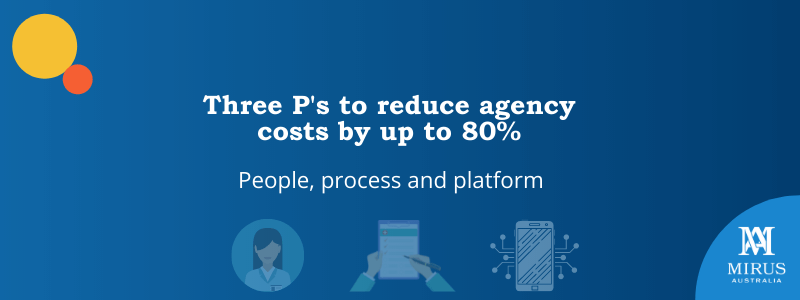How to reduce agency costs by up to 80%
October 26, 2021 | Workforce Management

By Tom Murphy, Head of Solutions
One of the frequent questions we hear from Aged Care providers is “how do we reduce agency costs?” In this blog, we share how Mirus Works clients have reduced their agency costs by up to 80% without cutting hours.
Sometimes, agency staff use is vital to ensure care delivery, but booking an agency shift can cost you 60% more than filling a vacancy with your own employees. In Aged Care this will become an increasingly important cost to manage as providers strive to meet their minimum staff time requirements. Fortunately, with some straightforward process improvements and the right technology, unplanned bookings and surprise bills can be significantly reduced.
By taking steps now to break the cycle of over-reliance on agency staff, your internal staff will be better off and more engaged, and your bottom line will look a lot healthier. If you’re spending more than 1% of your total workforce spend on agency staff and you’d like to see that as zero, you need to address the three P’s – People, Process, Platform.
Collaborate with your people
Before any new policies are established, it’s important to open a dialogue with staff. For change to be successful, it should be managed transparently and early. Ultimately, to reduce your agency spend, you need to make sure you can fill vacant shifts and this needs staff buy-in.
It may even be as simple as asking a question. During a recent workforce diagnostic we conducted with a client, 76% of surveyed employees said they would work more flexibly, but have never been asked.
Find out what works and what doesn’t about current shift patterns. Pleasing everyone is not realistic, but strive to find a balance that works for most.
Refine your policies and processes
It can be a lot harder to manage any change without a plan. So, setting out guidelines for your teams to follow in the event of a vacant shift can save time and money.
A good first step is to calculate what you’re currently spending on agency shifts and set a goal to reduce this.
Then, establish a policy for booking agency staff. Some things to consider for this policy include:
- Determine the need: Does the shift need to be replaced? Could someone’s shift be safely extended to cover the gap? What if someone from another area in the facility was re-allocated?
- Contact internal staff to offer the vacant shift.
- Seek approval from a manager for all agency bookings.
The adage ‘what gets measured gets managed’ is also crucial here. You will need to ensure agency cost can be tracked within your rostering platform. This means uploading agency rates for each shift so you can understand the cost in real-time rather than waiting for the bill.
It’s also worth considering standardised shift times. Aside from being difficult to administer, irregular shift times aren’t always attractive for employees. Consider scenarios where shift arrangements have been made to suit a specific employee but never reviewed. In practice, these shifts may not be meeting the needs of your roster and may prove tricky to fill.
Consider how a technology platform can eliminate the guesswork
We’ve already touched on how a rostering platform should help track the hours and cost of external staff. It’s equally important to track this for internal staff. Specifically, monitoring and mitigating ‘hours leakage’ will ensure all contracted hours are used up before turning to external help.
Contracted hours are the work hours an employer is obliged by law to make available to an employee. And these must be paid regardless of whether they work. ‘Hours leakage’ happens when you have under-utilised staff and you are reliant on agency (or overtime) to cover vacancies.
Careful planning in a good rostering platform will mitigate this leakage, but only real-time visibility of hours worked versus contracted will keep you on track. This is especially important when filling a shift vacancy.
The system should include tools that keep your workforce connected and help prioritise your staff to fill vacancies. Ideally, this should clearly display costs and hours, and configurable alerts to help you stay on top of fatigue.
Additionally, if you’re scheduling staff across more than one site, think about how staff could be shared across multiple nearby locations. Bear in mind that the technology you use will need to provide clear visibility of availability to avoid double ups.
Clients who have adopted these recommendations and managed them in Mirus Works have seen a reduction in agency spending by up to 80%. Better still, over a third of facilities using Mirus Works are even enjoying zero agency usage.
Are you ready to reduce unplanned agency costs?


